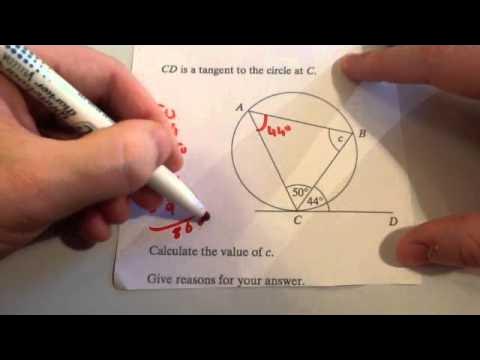Lingkaran kelas 11 / Video Teorema Lingkaran
Summary
TLDRIn this educational video, the instructor, Ibu Nita Hadianti, explains several theorems related to circles. These include the relationship between a radius and a chord, the Pythagorean theorem in circle geometry, and the properties of angles subtended by arcs. The video covers various examples and problems, including finding the radius of a circle and solving for unknown angles using theorems such as Thales' Theorem and the relationship between central and inscribed angles. The lesson encourages learners to apply these principles to solve mathematical problems related to circles.
Takeaways
- 😀 The first theorem states that a line drawn from the center of the circle, perpendicular to a chord, bisects the chord into two equal parts.
- 😀 Example: When given a chord AB (8 cm) and a perpendicular line OM (3 cm), the radius OB is calculated using the Pythagorean theorem, resulting in 5 cm.
- 😀 Thales' Theorem asserts that the angle subtended by a diameter of the circle at the circumference is always 90°.
- 😀 The sum of the angles in any triangle equals 180°, which is used to solve for unknown angles in geometric problems.
- 😀 In a triangle, if one angle is 90° and the other two are expressed in terms of a variable, we can solve for the variable using the equation for the sum of angles.
- 😀 Angles subtended by the same chord on the circumference of the circle are always equal, as shown with angles ACB and ADB in the example.
- 😀 The central angle is always twice the inscribed angle subtended by the same arc. This is exemplified by the relationship between angles AOB and ACB.
- 😀 In cyclic quadrilaterals, opposite angles always sum to 180°.
- 😀 Example: Given that angle ADC = 94° and angle BAD = 63°, the opposite angle ABC can be found by subtracting from 180° to get 86°.
- 😀 The lesson encourages practicing the theorems through exercises to improve understanding, ensuring that students grasp the core concepts in geometry.
Q & A
What does the first theorem in the script explain about the relationship between a radius and a chord?
-The first theorem explains that if a radius is drawn from the center of the circle and is perpendicular to a chord, it divides the chord into two equal parts.
In the example with chord AB and radius OM, how is the radius OB calculated?
-The radius OB is calculated using the Pythagorean theorem. Given OM = 3 cm and MB = 4 cm, the formula is OB^2 = OM^2 + MB^2, which results in OB = 5 cm.
What is Thales' Theorem and how is it applied in the script?
-Thales' Theorem states that the angle subtended by the diameter of a circle is a right angle (90 degrees). In the script, it is shown that if the angle at the center of the circle is 90 degrees, then the corresponding angle on the circle is also 90 degrees.
How can the unknown angle in a triangle be calculated using the sum of the angles?
-The sum of the angles in a triangle is always 180 degrees. In the example, if one angle is 90 degrees and the other is 3x, then the remaining angle x can be calculated by solving 4x + 90 = 180, which gives x = 22.5 degrees.
What is the relationship between angles subtended by two chords that face the same arc?
-The angles subtended by two chords on the circumference of the circle that face the same arc are equal in size.
What does the second part of the script explain about the angle at the center compared to the angle at the circumference?
-The second part explains that the angle at the center of the circle is always twice the angle at the circumference that subtends the same arc.
How do you calculate the angle at the circumference if the central angle is given?
-If the central angle is given, you can calculate the angle at the circumference by dividing the central angle by 2. For example, if the central angle is 110 degrees, the angle at the circumference is 55 degrees.
What is the rule for opposite angles in cyclic quadrilaterals?
-In a cyclic quadrilateral, the sum of opposite angles is always 180 degrees.
In the cyclic quadrilateral example, how is angle ABC calculated?
-In the example, the sum of opposite angles is 180 degrees. Given that angle ADC is 94 degrees, the angle ABC is calculated as 180 - 94, which equals 86 degrees.
What is the key message of the script regarding the importance of these theorems?
-The key message is that understanding and practicing these theorems is essential for solving geometry problems effectively, and students should stay motivated to keep learning and applying these principles.
Outlines

This section is available to paid users only. Please upgrade to access this part.
Upgrade NowMindmap

This section is available to paid users only. Please upgrade to access this part.
Upgrade NowKeywords

This section is available to paid users only. Please upgrade to access this part.
Upgrade NowHighlights

This section is available to paid users only. Please upgrade to access this part.
Upgrade NowTranscripts

This section is available to paid users only. Please upgrade to access this part.
Upgrade NowBrowse More Related Video
5.0 / 5 (0 votes)





